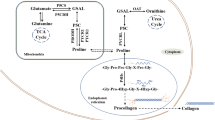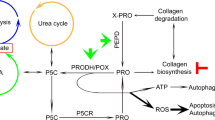Abstract
The resurgence of interest in tumor metabolism has led investigators to emphasize the metabolism of proline as a “stress substrate” and to suggest this pathway as a potential anti-tumor target. Proline oxidase, a.k.a. proline dehydrogenase (POX/PRODH), catalyzes the first step in proline degradation and uses proline to generate ATP for survival or reactive oxygen species for programmed cell death. POX/PRODH is induced by p53 under genotoxic stress and initiates apoptosis by both mitochondrial and death receptor pathways. Furthermore, POX/PRODH is induced by PPARγ and its pharmacologic ligands, the thiazolidinediones. The anti-tumor effects of PPARγ may be critically dependent on POX/PRODH. In addition, it is upregulated by nutrient stress through the mTOR pathway to maintain ATP levels. We propose that proline is made available as a stress substrate by the degradation of collagen in the microenvironmental extracellular matrix by matrix metalloproteinases. In a manner analogous to autophagy, this proline-dependent process for bioenergetics from collagen in extracellular matrix can be designated “ecophagy”.







Similar content being viewed by others
Abbreviations
- mTOR:
-
Mammalian target of rapamycin
- NFAT:
-
Nuclear factor of activated T-cells
- P5C:
-
Δ1-Pyrroline-5-carboxylic acid
- POX:
-
Proline oxidase
- PPARγ:
-
Peroxisome proliferator-activated receptor gamma
- PRODH:
-
Proline dehydrogenase
- ROS:
-
Reactive oxygen species
- TZDs:
-
Thiazolidinediones
References
Adams E (1970) Metabolism of proline and hydroxyproline. Int Rev Connect Tissue Res 5:1–91
Adams E, Frank L (1980) Metabolism of proline and the hydroxyprolines. Annu Rev Biochem 49:1005–1061
Adams E, Goldstone A (1960) Hydroxyproline metabolism. III. enzymatic synthesis of hydroxyproline from delta 1-pyrroline-3-hydroxy-5-carboxylate. J Biol Chem 235:3499–3503
Bauer DE, Harris MH, Plas DR, Lum JJ, Hammerman POS, Rathmell JC, Riley JL, Thompson CB (2004) Cytokine stimulation of aeroic glycolysis in hematopoietic cells exceeds proliferative demand. FASEB J 18(11):1303–1305 10.10-96/fj03-1001 fje
Campbell HD, Webb GC, Young JG (1997) A human homologue of the Drosophila melanogaster sluggish-A (proline oxidase) gene maps to 22q11.2, and is a candidate gene for type-I hyyperprolinemia. Hum Genet 101:69–74
Carter C, Shafir S, Yehonetaqn L, Palmer RG, Thornburg (2006) A novel role for proline in plant floral nectars. Naturwissenschaften 90:72–79
Cooper SK, Pandhare J, Donald SP, Phang JM (2008) A novel function for hydroxyproline oxidase in apoptosis through generation of reactive oxygen species. J Biol Chem (in press) Epub Feb 19
Dang CV, Semenza GL (1999) Oncogenic alterations of metabolism. Trends Biochem Sci 24:68–72
Dixit SN, Seyer JM, Kang AH (1977) Covalent structure of collagen: amino-acid sequence of chymotryptic peptides from the carboxyl-terminal region of α2-CB3 of chick-skin collagen. Eur J Biochem 81:599–607
Donald SP, Sun XY, Hu CA, Yu J, Mei JM, Valle D, Phang JM (2001) Proline oxidase, encoded by p53-induced gene-6, catalyzes the generation of proline-dependent reactive oxygen species. Cancer Res 61:1810–1815
Eggleston LV, Krebs HA (1974) Regulation of the pentose phosphate cycle. Biochem J 138:425–435
Fox CJ, Hammerman PS, Thompson CB (2005) Fuel feeds function: energy metabolism and the T-cell response. Nat Rev Immunol 5:844–852
Fries W, Giacomin D, Plebani M, Martin A (1994) Effect of experimental colitis on bone metabolism in the rat. Digestion 55:229–233
Gade G, Auerswald L (2002) Beetle’s choice—proline for energy output: control by AKHS. Comp Biochem Physiol B Biochem Mol Biol 132:117–129
Gogos JA, Santha M, Takacs Z, Berk KD, Laine V, Luers LR, Nadler JV, Karayiorgou M (1999) The gene encoding proline dehydrogenase modulates sensorimotor gating in mice. Nat Genet 21:434–439
Gordon G, Mackow MC, Levy HR (1995) On the mechanism of interaction of steroids with human glucose-6-phosphate dehydrogenase. Arch Biochem Biophys 318:25–29
Govindarajan R, Ratnasinghe L, Simmons DL, Siegel ER, Midathada MV, Kim L, Kim PJ, Owens RJ, Lang NP (2007) Thiazolidinediones and the risk of lung, prostate, and colon cancer in patients with diabetes. J Clin Oncol 20:1461–1462
Hagedorn CH, Phang JM (1983) Transfer of reducing equivalents into mitochondria by the interconversions of proline and Δ1-pyrroline-5-carboxylate. Arch Biochem Biophys 225:95–101
Hagedorn CH, Phang JM (1986) Catalytic transfer of hydride ions from NADPH to oxygen by the interconversions of proline and delta 1-pyrroline-5-carboxylate. Arch Biochem Biophys 248:166–174
Han S, Roman J (2007) Peroxisome proliferator-activated receptor gamma: a novel target for cancer therapeutics? Anticancer Drugs 18:237–244
Hechtman P (2001) Prolidase deficiency. In: Scriver CR, Beaudet AL, Sly WS, Valle D (eds) Metabolic and molecular basis of inherited disease. McGraw-Hill, New York, pp 1839–1856
Hu C-AA, Yu J, Lin W-W, Donald SP, Sun X-Y, Almashanu S, Steel G, Phang JM, Vogelstein B, Valle D (2001) Overexpression of proline oxidase, a p53 induced gene (PIG6) induces reactive oxygen species generation and apoptosis in cancer cells. Proc Am Assoc Cancer Res 42:225
Hu C-AA, Donald SP, Yu J, Lin W-W, Liu Z, Steel G, Obie C Valle D, Phang JM (2007) Overexpression of proline oxidase induces proline-dependent and mitochondria-mediated apoptosis. Mol Cell Biochem 295:85–92
Kim KY, Ahn JH, Cheon HG (2007) Apoptotic action of peroxisome proliferator-activated receptor-gamma activation in human non small-cell lung cancer is mediated via proline oxidase-induced reactive oxygen species formation. Mol Pharmacol 72:674–685 (Epub 2007 May 29)
Laconi E (2007) The evolving concept of tumor microenvironments. Bioessays 29:738–744
Li MY, Lee TW, Yim AP, Chen GG (2006) Function of PPARgamma and its ligands in lung cancer. Crit Rev Clin Lab Sci 43:183–202
Liedtke AJ, Renstrom B, Nellis SH (1992) Correlation between [5-3H]glucose and [U-14C]deoxyglucose as markers of glycolysis in reperfused myocardium. Circ Res 71:689–700
Liu Y, Borchert GL, Donald SP, Surazynski A, Hu C-A, Weydert CJ, Oberley LW, Phang JM (2005) MnSOD inhibits proline oxidase-induced apoptosis in colorectal cancer cells. Carcinogenesis 26:1335–1342
Liu Y, Borchert GL, Surazynski A, Hu C-A, Phang JM (2006) Proline oxidase activates both intrinsic and extrinsic pathways for apoptosis: the role of ROS/superoxides, NFAT and MEK/ERK signaling. Oncogene 25:5640–5647
Lu KP, Liou YC, Vincent I (2003) Proline-directed phosphorylation and isomerization in mitotic regulation and in Alzheimer’s disease. Bioessays 25:174 181
Lupi A, Roossi A, Campari E, Pecora F, Lund AM, Elcioglu NH, Gultepe M, DiRocco M, Cetta G, Forlino A (2006) Molecular characterization of 6 patients with prolidase deficiency: identification of the first small duplication in the prolidase gene and of a mutation generating symptomatic and asymptomatic outcomes. J Med Genet 43:e58
Malemud DJ (2006) Matrix metalloproteinases (MMPs) in health and disease. Front Biosci 11:1696–2701
Marian B, Mazzucco K (1985) Dermal collagen metabolism during tumor promotion with 12-O-tetradecanoylphorbol-13-acetate in mouse skin. Carcinogenesis 6:501–504
Maxwell SA, Rivera A (2003) Proline oxidase induces apoptosis in tumor cells, and its expression is frequently absent or reduced in renal carcinomas. J Biol Chem 278:9784–9789
Mazurek S, Zwerschke W, Jansen-Durr P, Eigenbrodt E (2001) Metabolic coooperation between different oncogenes during cell transformation: interaction between activated ras and HPV-16 E7. Oncogene 20:6891–6898
McAlpine CA, Barak Y, Matise I, Cormier RT (2006) Intestinal-specific PPARgamma deficiency enhances tumorigenesis in ApcMin/+ mice. Int J Cancer 119:2339–2346
Merrill MJ, Yeh GC, Phang JM (1989) Purified human erythrocyte pyrroline-5-carboxylate reductase. Preferential oxidation of NADPH. J Biol Chem 264:9352–9358
Micheu S, Crailsheim K, Leonhared B (2000) Importance of proline and other amino acids during honeybee flight. Amino acids 18:157–175
Natali A, Ferrannini E (2006) Effects of metformin and thiazolidinediones on suppression of hepatic glucose production and stimulation of glucose uptake in type 2 diabetes: a systematic review. Diabetologia 49:434–441 (Epub 2006 Feb 14)
Page-McCaw A, Ewald AJ, Werb Z (2007) Matrix metalloproteinases and the regulation of tissue remodelling. Nat Rev Mol Cell Biol 8:221–233
Pan JG, Mak TW (2007) Metabolic targeting as an anticancer strategy: dawn of a new era? Sci STKE 2007(381):pe14
Pandhare J, Cooper SK, Phang JM (2006) Proline oxidase, a proapoptotic gene, is induced by troglitazone: evidence for both peroxisome proliferator-activated receptor gamma-dependent and -independent mechanisms. J Biol Chem 281:2044–2052. (Epub 2005 Nov 21)
Pandhare J, Cooper SK, Donald SP, Phang JM (2007) The importance of proline metabolism under conditions of nutrient stress. Proc Am Assoc Cancer Res 48:4501
Pandhare J, Cooper SK, Donald SP, Phang JM (2008) Significance of the proline metabolic pathway in the adaptation of cancer cells to nutrient/energy limitation (submitted)
Parks WC, Wilson CL, Lopez-Boado YS (2004) Matrix metalloproteinases as modulators of inflammation and innate immunity. Nat Rev Immunol 4:617–629
Phang JM (1985) The regulatory functions of proline and pyrroline-5-carboxylic acid. Curr Topics Cell Regul 25:91–132
Phang JM, Downing SJ, Yeh GC (1980) Linkage of the HMP pathway to ATP generation by the proline cycle. Biochem Biophys Res Commun 93:462–470
Phang JM, Hu CA, Valle D (2001) Disorders of proline and hydroxyproline metabolism. In: Scriver CR, Beaudet AL, Sly WS, Valle D (eds) Metabolic and molecular basis of inherited disease. McGraw-Hill, New York, pp 1821–1838
Polyak K, Xia Y, Zweier JL, Kinzler KW, Vogelstein B (1997) A model for p53-induced apoptosis. Nature 389:300–305
Reddy GK, Dhar SC (1989) Metabolism of collagen in bone of adjuvant induced arthritic rat. Bone 10:439–445
Reiling JH, Sabatini DM (2006) Stress and mTOR signaling. Oncogene 25:6373–6383
Rubinsztein DC, DiFiglia M, Heinz N, Nixon RA, Qin ZH, Ravikumar B, Stefanes L, Tedkovsky A (2005) Autophagy and its possible roles in nervous system diseases, damage and repair. Autophagy 1:11–22
Semenza GL (2007) Hypoxia-inducible factor 1 (HIF-1) pathway. Sci STKE 2007(407):cm8
Schwartz LM, Smith SW, Jones ME, Osborne BA (1993) Do all programmed cell deaths occur via apoptosis? Proc Natl Acad Sci USA 90:980–984
Stallings-Mann M, Radisky D (2007) Matrix metalloproteinase-induced malignancy in mammary epithelial cells. Cells Tissues Organs 185:104–110
Strauss DS, Glass CK (2007) Anti-inflammatory actions of PPAR ligands: new insights on cellular and molecular mechanisms. Trends Immunol 28:551–558. (Epub 2007 Nov 5)
Surazynski A, Donald SP, Cooper SK, Whiteside MA, Salnikow K, Liu Yk Phang JM (2007) Extracellular matrix and HIF-1 signaling: the role of prolidase. Int J Cancer Nov 12 (Epub ahead of print)
Valle D, Goodman SI, Harris SC Phang JM (1979) Genetic evidence for a common enzyme catalyzing dthe 2nd step in the degradation of proline and hydroxyproline. J Clin Invest 64:1365–1370
Van Wijk JP, Rabelink TJ (2005) Impact of thiazolidinedione therapy on atherogenesis. Curr Atheroscler Rep 7:369–374
Wagenaar-Miller RA, Gorden L, Matrisian LM (2004) Matrix metalloproteinases in colorectal cancer: is it worth talking about? Cancer Met Rev 23:119–135
Wang X, Fu X, Brown PD, Crimmin MJ, Hoffman RM (1994) Matrix metalloproteinase inhibitor BB-94 (batimastat) inhibits human colon tumor growth and spread in a patient-like orthotopic model in nude mice. Cancer Res 54:4726–4728
Warburg O (1930) Ueber den Stoffwechsel der Tumoren. Constable, London
White TA, Krishnan N, Becker DF, Tanner JJ (2007) Structure and kinetics of monofunctional proline dehydrogenase from Thermus thermophilus. J Biol Chem 282:14316–14327 (Epub 2007 Mar 7)
Yorimatsu T, Klonskhy DJ (2005) Autophagy, molecular machinery for self-eating. Cell Death Differ 12:1542–1552
Acknowledgments
This research is supported by the Intramural Research Program of the NIH, National Cancer Institute, Center for Cancer Research. This project also has been funded in part with Federal funds from the National Cancer Institute, National Institutes of Health under Contract No. N01-CO-12400.
Author information
Authors and Affiliations
Corresponding author
Additional information
The content of this publication does not necessarily reflect the views or policies of the Department of Health and Human Services, nor does mention of trade names, commercial products, or organizations imply endorsement by the US Government.
Rights and permissions
About this article
Cite this article
Phang, J.M., Donald, S.P., Pandhare, J. et al. The metabolism of proline, a stress substrate, modulates carcinogenic pathways. Amino Acids 35, 681–690 (2008). https://doi.org/10.1007/s00726-008-0063-4
Received:
Accepted:
Published:
Issue Date:
DOI: https://doi.org/10.1007/s00726-008-0063-4




